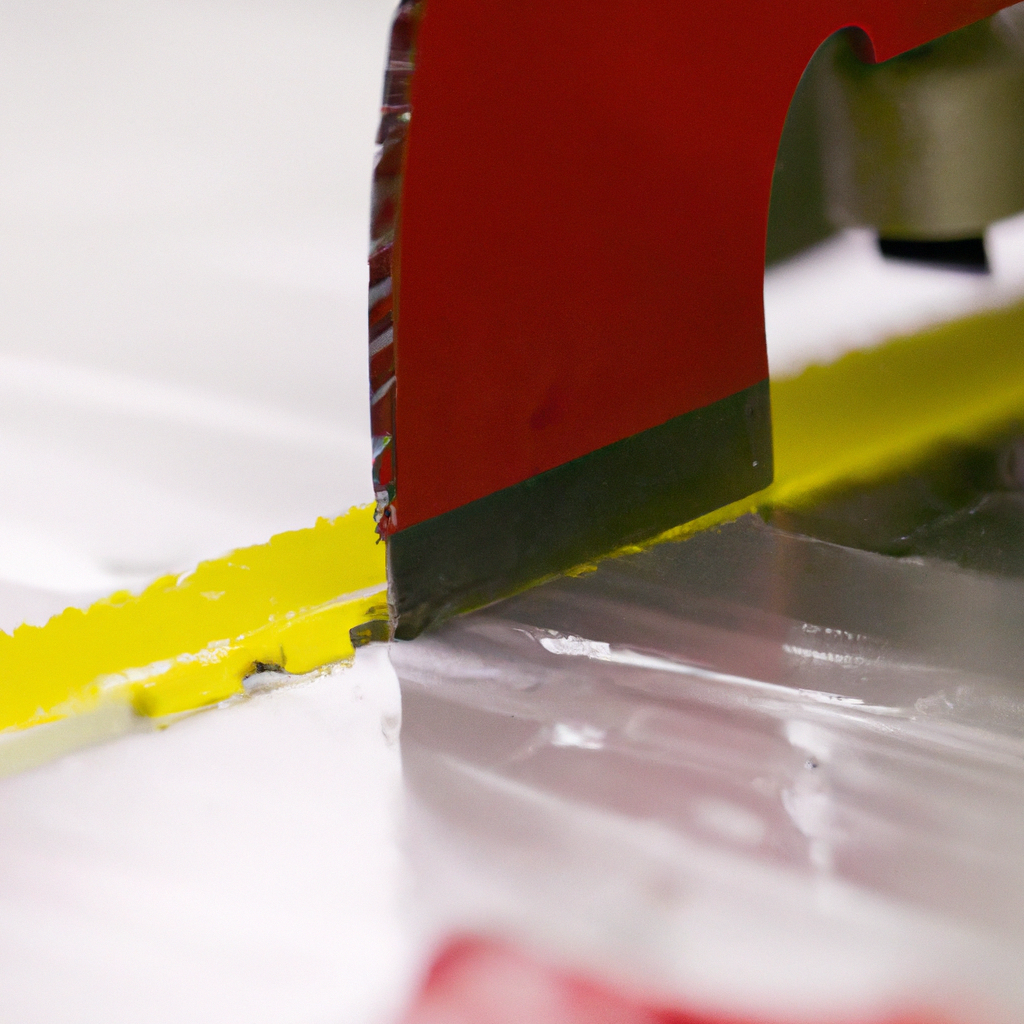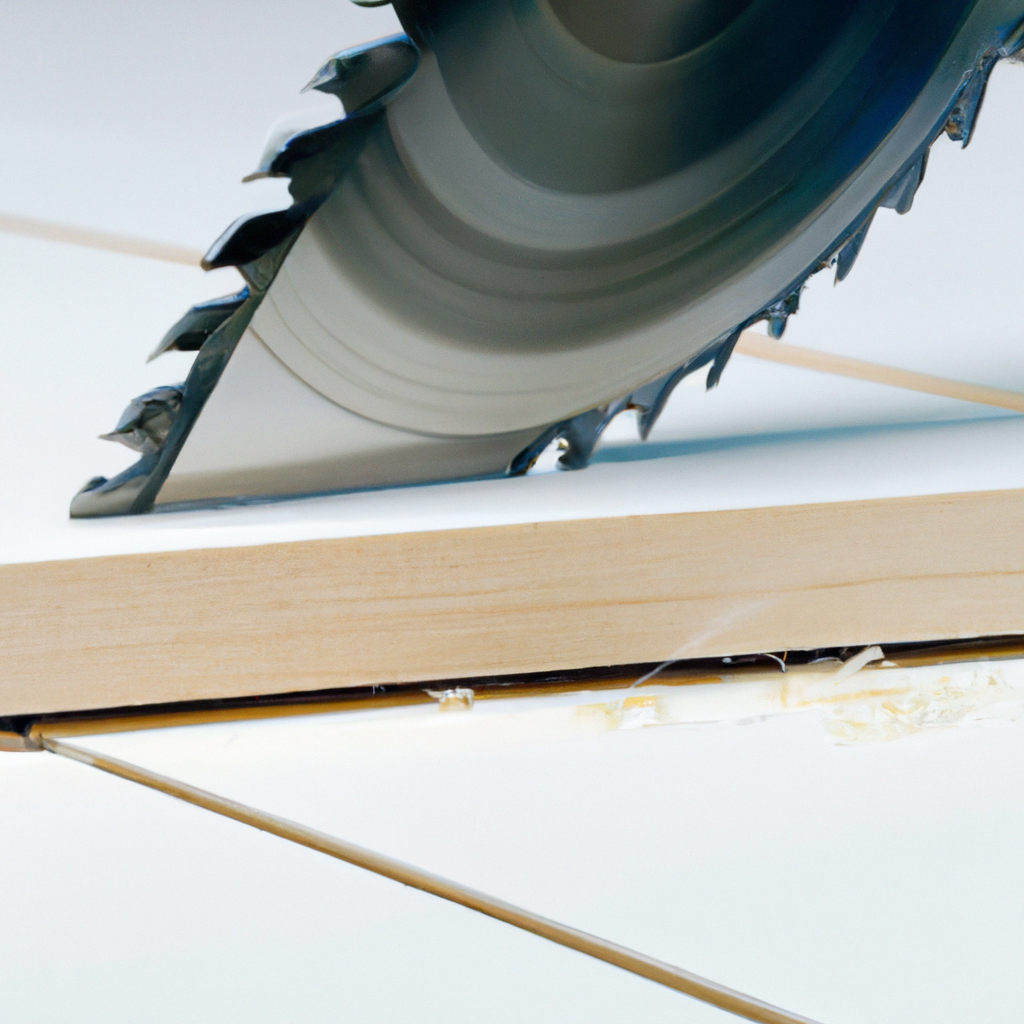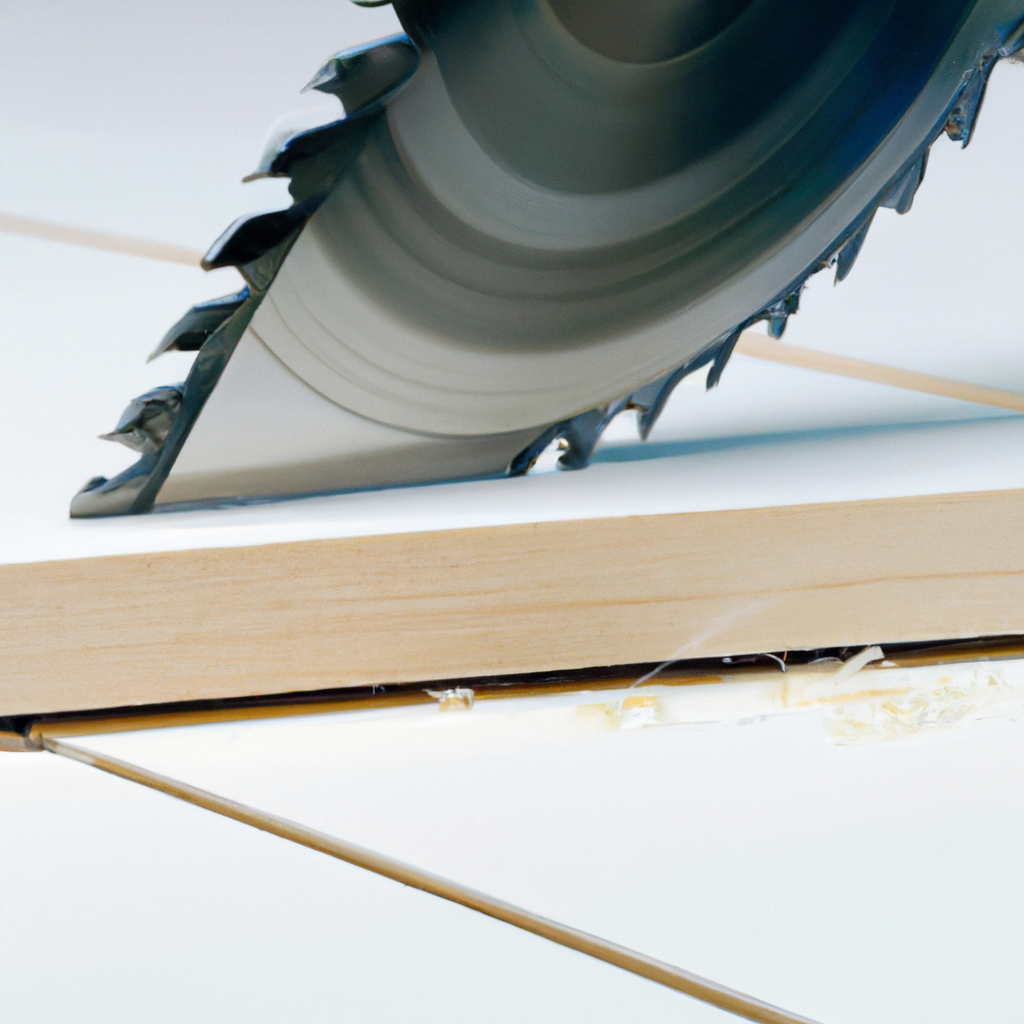Have you ever wondered if a table saw is capable of cutting polycarbonate? In this article, we will explore the feasibility of using a table saw for cutting polycarbonate materials. Polycarbonate, known for its durability and versatility, is commonly used in construction, DIY projects, and even in the manufacturing of safety glasses. Join us as we delve into the potential of utilizing a table saw to tackle polycarbonate cutting tasks.

Step 1: Understand Polycarbonate
Overview of polycarbonate material
Polycarbonate is a versatile and durable thermoplastic material that is commonly used in various applications. It is known for its high impact resistance, clarity, and strength. Polycarbonate is often used as a substitute for glass due to its lightweight nature and resistance to shattering. It is widely used in industries such as automotive, construction, electronics, and even in household items like water bottles and eyeglass lenses.
Properties and characteristics of polycarbonate
Polycarbonate possesses several favorable properties and characteristics that make it an ideal material for many applications. It has excellent transparency, allowing for a clear and unobstructed view. Its high impact resistance makes it resistant to breakage or cracking even under intense pressure. Polycarbonate is also known for its exceptional thermal resistance, which allows it to withstand high temperatures without melting or deforming.
Applications of polycarbonate
Due to its unique properties, polycarbonate finds a wide range of applications in different industries. In the automotive sector, it is used for manufacturing headlight lenses, windows, and protective covers. In construction, polycarbonate is often used for greenhouse panels, skylights, and safety glazing. It is also widely used for electrical components, electronic displays, and protective screens for electronic devices. Additionally, polycarbonate is utilized in various consumer goods such as eyewear, water bottles, and sports equipment.
Step 2: Assess Safety Precautions
Wear protective gear
When working with polycarbonate, it is essential to prioritize your safety by wearing appropriate protective gear. This includes safety goggles to protect your eyes from any flying debris, a dust mask or respirator to prevent inhalation of fine particles, and gloves to protect your hands from potential cuts or abrasions. Wearing long sleeves and pants can also provide additional protection.
Ensure proper ventilation
Polycarbonate cutting can produce fine dust particles and fumes, which can be harmful if inhaled. It is important to work in a well-ventilated area to ensure the dispersion of these particles. If possible, consider working outdoors or in an area with a local exhaust ventilation system that can remove the dust and fumes effectively.
Secure the workpiece
Before starting the cutting process, make sure the polycarbonate sheet is securely positioned on a stable and level surface. Properly secure the sheet using clamps or other suitable methods to prevent movement during cutting. This will ensure accurate and safe cuts.
Use a blade guard
Table saws are often equipped with a blade guard, which serves as a protective barrier between you and the spinning blade. Make sure to use the blade guard when cutting polycarbonate to prevent accidental contact with the blade. The blade guard also helps to reduce the risk of flying debris.
Work in a well-lit area
Good visibility is crucial when working with any power tool, especially when dealing with a material as transparent as polycarbonate. Adequate lighting will help you accurately mark the cut lines and maintain a safe cutting path. Ensure that the area surrounding your table saw is well-lit to ensure optimal visibility.
Step 3: Select the Right Blade
Understanding the importance of blade selection
Choosing the right blade for cutting polycarbonate is crucial to achieve clean and accurate cuts. A blade specifically designed for cutting plastics will provide the best results. Using the wrong blade can lead to chipping, melting, or even shattering of the polycarbonate sheet.
Types of blades suitable for cutting polycarbonate
There are various types of blades available for cutting polycarbonate, including crosscut blades, fine-toothed blades, and triple-chip grind blades. Crosscut blades are designed to cut materials across the grain and are suitable for general-purpose cutting. Fine-toothed blades have a higher tooth count and are ideal for achieving smooth and clean cuts on polycarbonate. Triple-chip grind blades feature alternating bevels and are known for their durability and chip-free cutting performance.
Tooth count and blade material considerations
When selecting a blade, tooth count is an important factor to consider. Blades with higher tooth counts, such as 80 to 100, are generally recommended for cutting polycarbonate. The higher tooth count allows for more teeth to come into contact with the material, resulting in smoother and cleaner cuts.
In addition to tooth count, blade material is also crucial. Carbide-tipped blades are highly recommended for cutting polycarbonate due to their durability and heat resistance. They are designed to withstand the high friction and heat generated during the cutting process, ensuring longevity and minimizing the risk of blade dulling.

Step 4: Set Up Your Table Saw
Check the alignment of the saw blade
Before starting any cutting operation, it is important to ensure that the saw blade is correctly aligned. Check if the blade is parallel to the miter slots and set it at a 90-degree angle to the table surface. This alignment is crucial for achieving accurate and straight cuts.
Adjust the rip fence and miter gauge
The rip fence and miter gauge are essential components of a table saw that help guide the material during cutting. Adjust the rip fence according to the desired width of the cut. Ensure it is firm and parallel to the blade. The miter gauge is used for making angled cuts. Adjust it to the desired angle, ensuring it fits securely in the miter slot and allows smooth movement.
Ensure the blade height is appropriate
The height of the saw blade should be adjusted according to the thickness of the polycarbonate sheet being cut. Ideally, the blade should extend approximately 1/8 inch above the thickness of the material. Adjust the blade height accordingly to prevent excessive friction and minimize the risk of chipping or melting.
Step 5: Prepare the Polycarbonate Sheet
Measure and mark the cut line
Carefully measure and mark the desired cut line on the polycarbonate sheet using a measuring tape and a fine-tipped marker or a scribe. Double-check the measurements to ensure accuracy. Use a straightedge or a square to create a straight and precise cut line.
Secure the sheet to a stable surface
To prevent any movement or vibrations during cutting, securely clamp the polycarbonate sheet to a stable work surface. Use clamps that will not damage or deform the material. Properly securing the sheet will help maintain accuracy and prevent any potential accidents.
Consider using a cutting template or guide
If you need to make multiple identical cuts or complex shapes, consider using a cutting template or guide. A template can be made from a durable material such as plywood or acrylic, which can be used as a guide for repeated cuts. This ensures consistency and precision throughout the cutting process.
Step 6: Cutting Techniques
Straight cuts using the rip fence
For straight cuts, position the rip fence parallel to the cut line. Hold the polycarbonate sheet firmly against the rip fence and slowly push it through the blade. Maintain a steady and consistent feed rate, allowing the blade to do the cutting while you guide the material. Keep your fingers well clear of the blade and always stay focused on the cutting process.
Angle cuts using a miter gauge
To make angled cuts, adjust the miter gauge to the desired angle. Position the polycarbonate sheet against the miter gauge, ensuring it is securely held in place. Slowly push the material through the blade while maintaining control and a steady feed rate. Take extra precautions when cutting angles to ensure accuracy and prevent any kickbacks.
Curved cuts using a template or guide
When cutting curves or irregular shapes, it is best to use a template or guide. Attach the template or guide to the polycarbonate sheet, following the marked cut line. Use a jigsaw or coping saw to carefully cut along the template, ensuring a smooth and accurate cut. Take your time and use light pressure to avoid damaging the material.
Avoid stopping or reversing the cut
While cutting polycarbonate, it is important to maintain a continuous and fluid cutting motion. Avoid stopping or reversing the cut, as this can cause chipping or melting of the material. If you need to adjust your position or make corrections, safely turn off the saw and reposition the sheet before recommencing the cut.
Step 7: Ensuring Clean and Smooth Cuts
Avoid applying excessive pressure
Polycarbonate is a relatively soft material, and applying excessive pressure during cutting can cause the material to deform or crack. Allow the blade to do the work and avoid forcing the material through the saw. Applying gentle and consistent pressure will result in clean and smooth cuts.
Control the feed rate
Maintaining a steady and controlled feed rate is crucial for achieving clean cuts. Pushing the polycarbonate sheet too quickly can lead to uneven cuts or chipping. Conversely, feeding the material too slowly can cause excessive heat buildup, resulting in melting or warping. Find a comfortable and consistent feed rate that allows for smooth cutting without compromising the material.
Ensure the blade is sharp
A sharp blade is essential for achieving clean and precise cuts on polycarbonate. Dull blades can cause tearing, chipping, or melting of the material. Regularly inspect the blade for any signs of dullness or damage, and replace it if necessary. A sharp blade will provide cleaner cuts and minimize the risk of accidents.
Use appropriate cutting lubricants
Using cutting lubricants can help reduce friction and heat buildup during the cutting process. Spray or apply a suitable lubricant, such as a silicone-based lubricant or a cutting wax, to the blade before cutting. This will help improve the overall cutting performance and extend the life of the blade. Remember to use lubricants sparingly and follow the manufacturer’s instructions.
Step 8: Post-Cutting Considerations
Remove any burrs or rough edges
After completing the cuts, carefully inspect the edges of the polycarbonate sheet for any burrs or rough edges. Use a deburring tool or a fine file to remove any imperfections and create smooth edges. This will ensure a clean and professional finish.
Smooth the cut edges using sandpaper
To further enhance the smoothness of the cut edges, gently sand them using fine-grit sandpaper. Sanding will help remove any remaining rough areas and create a polished appearance. Gradually increase the grit of the sandpaper until the desired smoothness is achieved.
Clean and store the saw properly
Once you have finished cutting the polycarbonate, clean the saw thoroughly to remove any dust or debris. Wipe down the table surface, remove the blade guard, and clean it separately. Properly store the saw in a dry and secure location to prevent any damage or accidents.
Step 9: Alternative Cutting Methods
Using a circular saw
If you do not have access to a table saw, a circular saw can be an alternative for cutting polycarbonate. Choose a blade specifically designed for plastics, and adjust the blade height and cutting depth accordingly. Secure the polycarbonate sheet to a stable surface and follow the same safety precautions and cutting techniques outlined earlier.
Using a jigsaw
A jigsaw is a versatile tool that can be used for cutting curves and irregular shapes in polycarbonate. Attach the appropriate blade for cutting plastics and secure the polycarbonate sheet to a stable surface. Use the jigsaw to carefully follow the marked cut line, maintaining control and a steady cutting motion. Remember to wear protective gear and work in a well-ventilated area.
Using a bandsaw
A bandsaw can also be used for cutting polycarbonate, especially when dealing with thicker sheets or intricate cuts. Choose a blade suitable for cutting plastics and set the appropriate blade tension. Secure the polycarbonate sheet with suitable clamps and follow the same safety precautions as mentioned earlier. Feed the material through the bandsaw, adhering to a steady and controlled feed rate.
Step 10: Safety Tips for Working with Polycarbonate
Avoid inhaling dust or fumes
Polycarbonate cutting can produce fine dust particles and fumes that may be harmful when inhaled. Always work in a well-ventilated area, wear a dust mask or respirator, and take breaks to breathe fresh air. Consider using dust collection systems or air purifiers to further minimize the exposure to dust and fumes.
Use proper eye and respiratory protection
Protecting your eyes is crucial when working with polycarbonate. Wear safety goggles that provide appropriate impact protection and shield your eyes from any flying debris. Additionally, use a dust mask or respirator to prevent inhalation of fine particles. Ensure that the protective gear fits properly and is comfortable to wear.
Work in a well-ventilated area
Proper ventilation is essential when working with polycarbonate, as it helps to disperse any dust or fumes produced during cutting. If possible, work in an outdoor area or a space with effective ventilation systems. Open windows or use fans to ensure a constant flow of fresh air. Taking regular breaks and avoiding prolonged exposure can further reduce the risk of inhaling harmful particles.
By following these comprehensive steps and safety tips, you can effectively cut polycarbonate with a table saw or other suitable cutting tools. Prioritize your safety, choose the right blade, and adhere to proper cutting techniques to ensure accurate and clean cuts. Whether you are working on a DIY project or a professional application, cutting polycarbonate can be a rewarding and successful task when done correctly.

